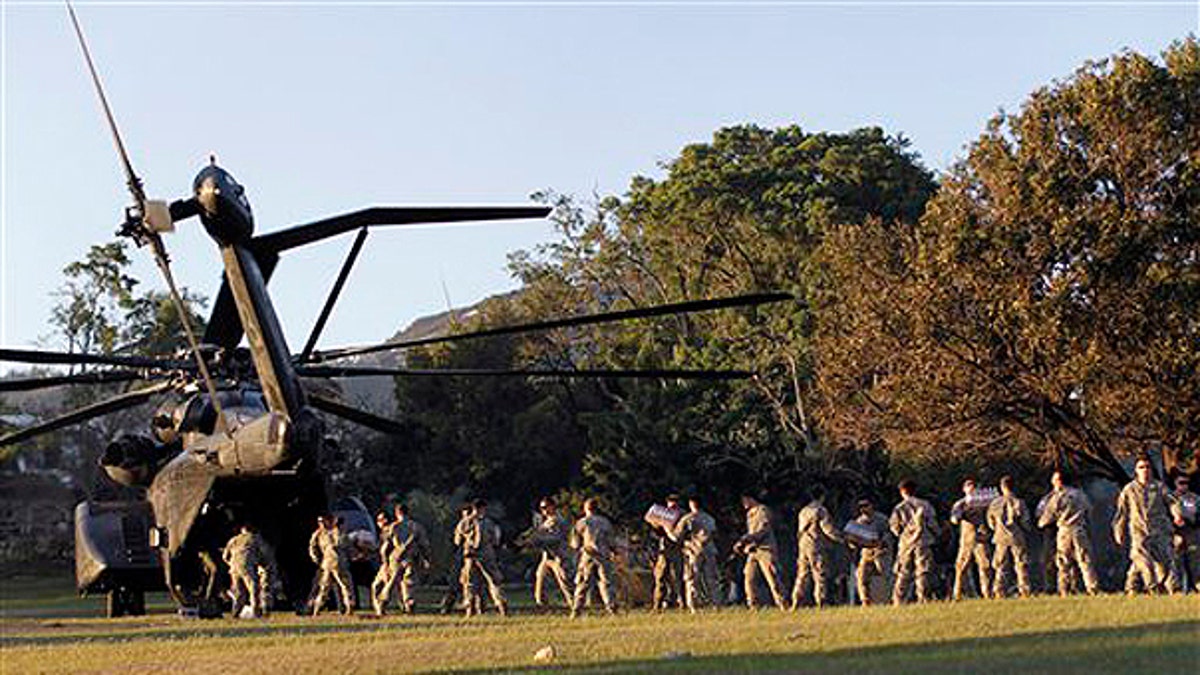
Monday: U.S. troops with the 82nd Airborne Division unload disaster relief supplies in Port-au-Prince. Troops, doctors and aid workers flowed into Haiti on Monday even while hundreds of thousands of Tuesday's quake victims struggled to find water or food. (AP Photo)
A full parking lot is to blame for the bottleneck at the airport in Port-au-Prince, Haiti, where relief supplies after last week's massive earthquake are being stored and distributed -- if the cargo planes carrying them can land.
Several complaints have been made about the number of planes diverted, and the French and Brazilians reportedly have filed specific criticisms to the State Department.
But military officials said the United States, which is in charge of the airport, is trying to move planes through the tarmac as quickly as possible. They said space constraints have presented a challenge as they work around the clock to offload relief supplies.
"It literally became, if there was a parking space open, we would get them on the ground and get them in here. Unfortunately sometimes, you got big aircraft that occupy a big spot on the ramp and we can't get them out fast enough -- and so people are having to hold to get in," Air Force Col. Ben McMullen told Fox News.
The airport has room for about a half-dozen planes to park, depending on their size, said Col. Buck Elton, the U.S. Southern Command commander for south Haiti. He said the 10,000-foot strip is accustomed to hosting three aircraft on a daily basis.
As of Sunday, five days after the 7.0-magnitude quake devastated Haiti's capital, the U.S. military, working with sparse equipment and primitive controls, has managed about 600 landings and take-offs.
"The airfield has not been closed since we started operation. It has just been full," Elton said, noting that the facility can hold about one wide-body and five narrow-body aircraft as well as three smaller aircraft at any given time.
"Any aircraft that can taxi into the grass and get off the ramp that the big aircraft need to be on, we use that option," he added.
Approximately 40 percent of the aircraft landing are military and 60 percent civilian.
Despite the complaints, Elton said just three planes were diverted on Sunday out of 67 civilian flights that arrived. The difficulty of the process has been compounded by the fact that the tower and terminal have been condemned due to the damage and all of the operations are being done in the grass between the runway and ramp.
"It's done via radio control from our controllers that are in contact with the Haitian approach control that does not have an operational radar or any navigational aids to assist the arrival of the aircraft, and with a communications link that we have back to the Haitian flight operations coordination center back at Tyndall Air Force Base in Florida," Elton said.
Elton said that occasionally "improperly configured cargo" that needs to be off-loaded by hand, equipment breakage and aircraft problems have forced planes to stay on the ground past the two or three hours allotted per plane. When that happens, other planes are caught up in the air.
He added that the military is using aircraft with refueling tankers on them so when an inbound civilian plane needs to land to offload its cargo, the military plane can manage to stay in the air, then quickly come down and offload it cargo and get back up in the air again with minimal time on the ground.



